Get started quickly, see results immediately, no code needed.
8 Must-Have Workflow Tools To Make Your Team More Productive
85% of your company’s data is unstructured. That’s why workflow tools are crucial if you want to avoid wasting time and making mistakes.
At Process Street, our mission is to make recurring work fun, fast, and faultless. Hence, our overwhelming desire to create a workflow for anything and everything. You guessed it – this piece of content went through our very own blog production workflow.
We see the immense benefits we’ve gotten from using workflow tools in our company. We’ve helped others achieve these same benefits, and now it’s time to help you.
You’ve got endless workflow tools at your disposal. But which one is the right choice for you?
We’ve done the heavy lifting by sifting through all the workflow tools labeled as the best and found the top 5 that can seriously change the way you work.
Our comparison criteria: How we determined the best workflow tools
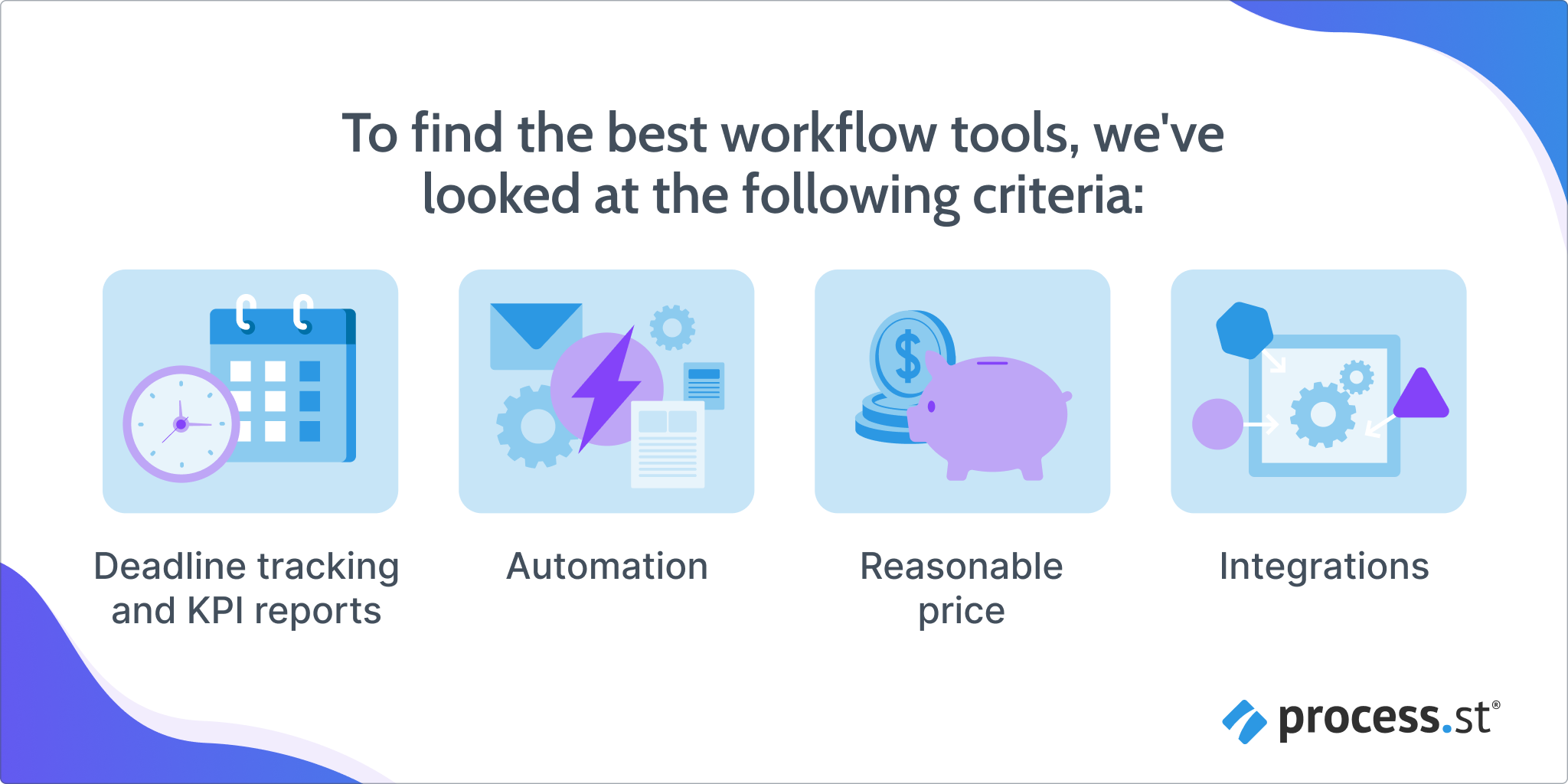
The best workflow tools will be ones that align with your exact budget and needs.
To decide what tools to include in this list, I’ve considered the key functions and features needed for business of all sizes.
Here’s how I found the best:
Deadline tracking and KPI reports
It can be difficult to keep track of deadlines when you’re juggling multiple workflows. For a workflow tool to be useful, it needs to be able to do the tracking for you. This should be both through a dashboard and individual notifications.
When selecting workflow tools for this list, I only considered ones that offered notification, dashboard views, and color-coding that display your tasks due date But it’s not just deadlines you want to track, it’s process status too.
KPI reports empower you to highlight inefficiencies within your workflows. This insight helps you make the necessary changes to optimize your business processes. The best workflow tools provide accurate and easy-to-intepret KPI dashboard to help you make these informed decisions and stay on top of your processes.
Automation
You don’t just want a workflow tool that helps you create workflows. Your chosen workflow tool need to have the capability to streamline the process. That means providing exceptional automation features. I’ve only included workflow tools that help you streamline recurring tasks and ultimately let you work more efficiently and with fewer errors.
Price
The value you receive from your workflow tool should correlate to the price you pay for it. Your chosen workflow tool should also align with your budget. You don’t want to be paying for features that you and your team don’t use. But most importantly, you want a workflow tool that scales with you. As the needs of your business, so do the features you require from your workflow tool.
Integrations
Multiple tools need to be used if you want to be running your business processes as efficiently as possible. Optimizing your workflows means creating an entire ecosystem of BPM tools that help you do just that. That means you need a workflow tool that offers integrations with these other software systems.
- Process Street
- Hive
- Miro
- SmartSheet
- SweetProcess
Our top pick of the best workflow tools available
The best workflow tool for optimizing workflows
A list of the best workflow tools wouldn’t be complete without Process Street. We’re confident in our product’s title as one of the best workflow tools. And we don’t just say this as seller of Process Street, but also as daily users, too!
Process Street is a workflow tool designed with no-code functionality that lets users document company processes with ease. But more than just documenting, Process Street’s exceptional automation capabilities help turn these recurring company processes into streamlined and interactive workflows. You also have +1,000 integration capabilities with many popular work applications including Salesforce, Slack, and DocuSign.
These workflows are stored in a centralized knowledge base alongside valuable documentation – Pages. Control over the accessibility of these workflows and documents can be managed to ensure complete transparency over organizational processes.
Process Street’s features include:
- Conditional Logic to adapt workflows to different scenarios within recurring processes
- Permissions and guest users for internal and external collaboration
- Automations to streamline recurring tasks
- Pages are stored alongside existing workflows to create a centralized knowledge base
Pros:
- All company processes and documentation are stored within one platform
- Data can be collected from or sent to other popular work apps
- No-code functionality creates a great user experience
Cons:
- The premade template library is difficult to navigate
Learn about Process Street’s pricing here.
The best workflow tool for spreadsheet users
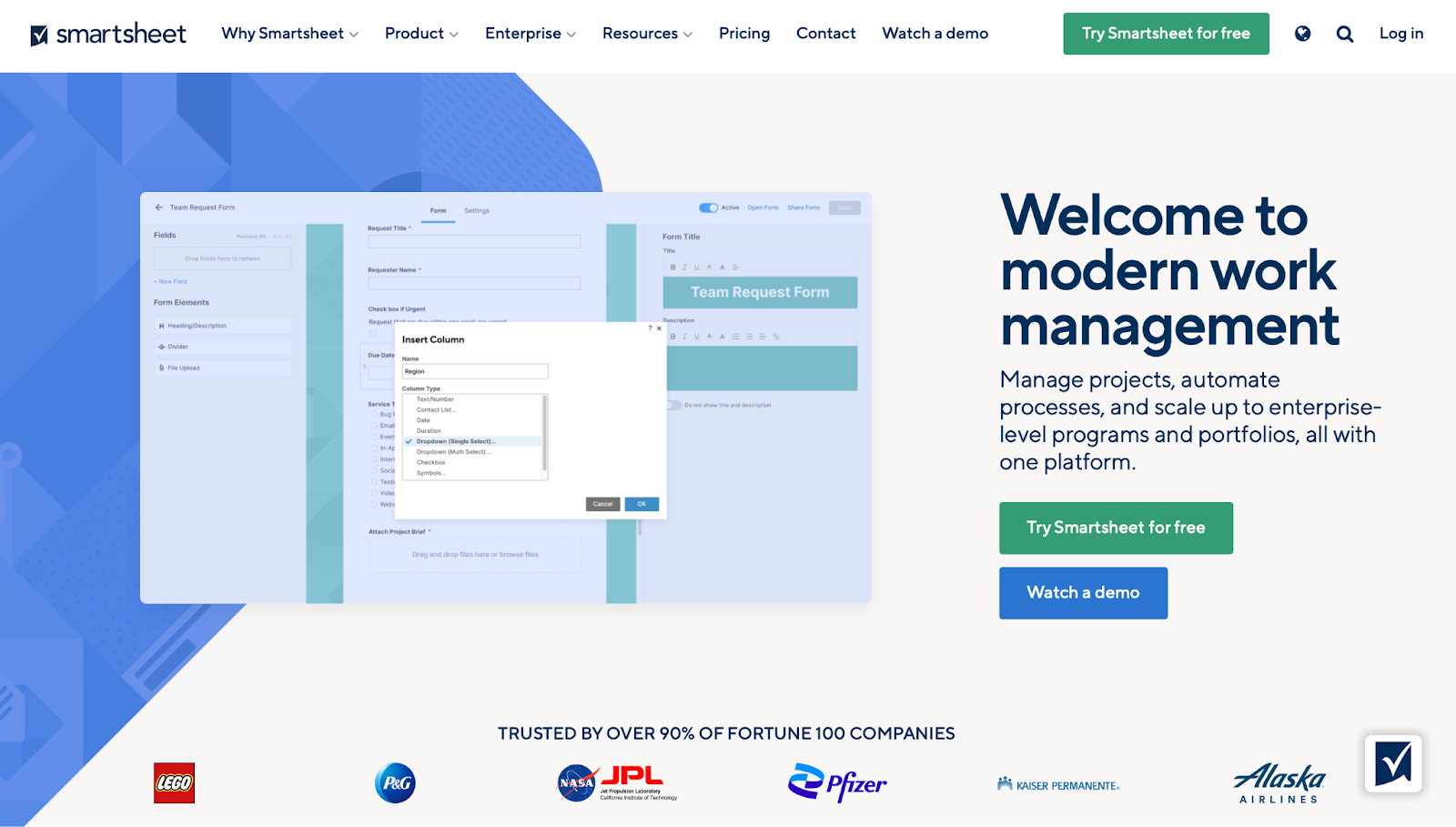
Smartsheet is a workflow tool that is inspired by ordinary spreadsheets. It’s designed for users to organize processes, schedules, and tasks in a spreadsheet-like format. Because of this spreadsheet model, it’s an excellent option for teams who currently use Microsoft Excel or Google Sheets and want to upgrade their experience.
When using Smartsheet, you can automate any calculations, even ones spanning across multiple documents. This automation capabilities empowers managers to collect information from multiple documents with almost no data entry needed. You also have access to strong reporting features with editable report summaries, which you can export to Google Sheets or Microsoft Excel.
Smartsheet’s features include:
- Critical Path that highlights all tasks directly impacted project completion
- Custom spreadsheet imports
- Integration capabilities with webhooks (including Microsoft Teams and Office apps, Tableau, Slack, Slaesforce, and Jira) and a REST API
- Formula calculation and workflow automation
Pros:
- Easy note-sharing and collaboration
- No need to write complex formulas
- Important milestones can be viewed with Critical Path
Cons:
- Limited activity log
- Steep learning curve and interface isn’t user-friendly
Learn about Smartsheet’s pricing here.
The best workflow tool for process mapping
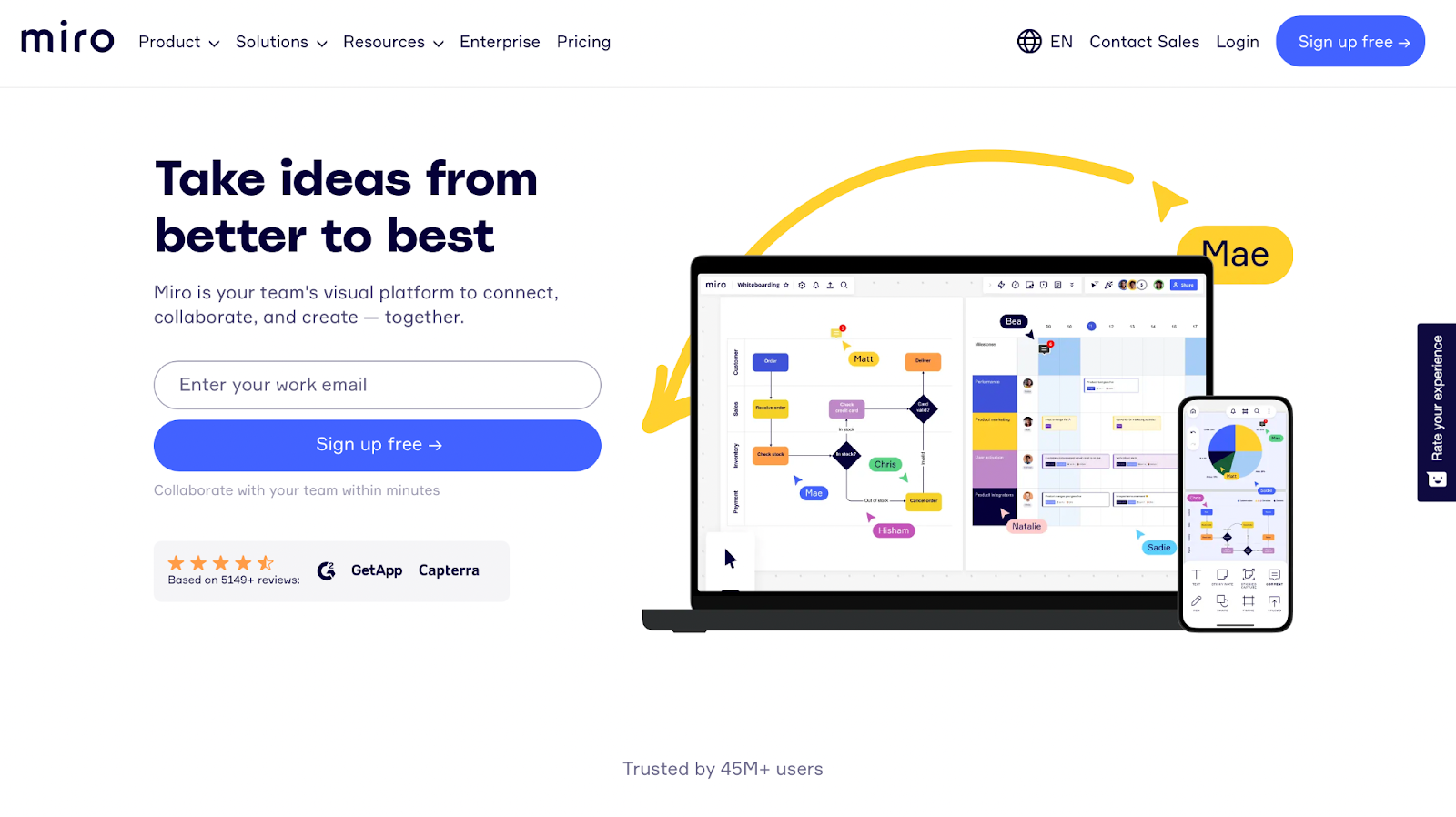
Miro is the right choice if you’re searching for a collaborative whiteboard platform. With this workflow tool, you can run agile workshops, facilitate meetings, showcase ideas, and collaborate in real-time and asynchronously with your team.
You have a template library to browse through different workflows to help you easily construct company processes. Its wide software integration capabilities include Slack, Zoom, Trello, and Jira. Hybrid and remote teams especially enjoy using Miro for process mapping.
Here at Process Street, we use Miro alongside our native workflow tool when running internal workflows.
Miro’s features include:
- Mouse-over collaboration for easy navigation
- Hundreds of integration options to choose from, including Process Street, Slack, and Zoom
- A library of premade templates
Pros:
- Easy to use with a no-code interface
- Access and visibility is straightforward to control
- Great collaborative experience
Cons:
- Editing tools are limited
- Credit cards are the only payment method
Learn about Miro’s pricing here.
The best workflow tool for task and project management
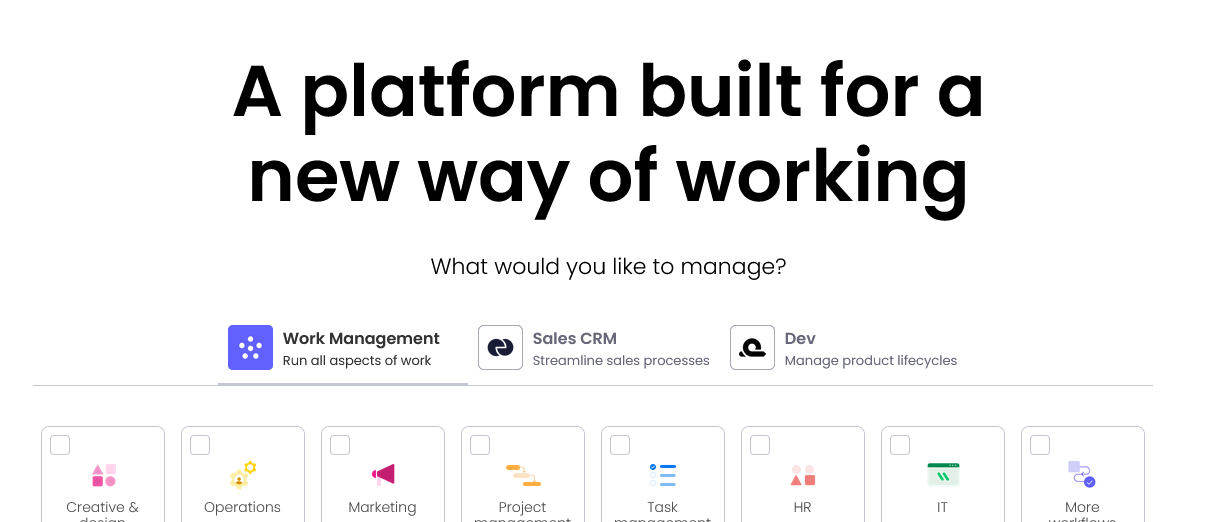
Monday.com is a highly customizable workflow management platform that allows teams to collaborate, plan, and track work in one centralized hub. With features like customizable templates, visual project tracking, and integration with popular tools like Slack, Zoom, and Microsoft Teams, Monday.com streamlines communication and enhances productivity.
Key Features:
- Customizable templates for various workflows
- Visual project tracking with customizable boards and timelines
- Integration with popular work applications
- Collaboration features such as @mentions and file sharing
Pros:
- Highly customizable to fit different team needs
- User-friendly interface with drag-and-drop functionality
- Robust reporting and analytics capabilities
- Mobile app for on-the-go access
Cons:
- Pricing can be on the higher side for larger teams
- Learning curve for advanced features
Learn about Monday.com’s pricing here.
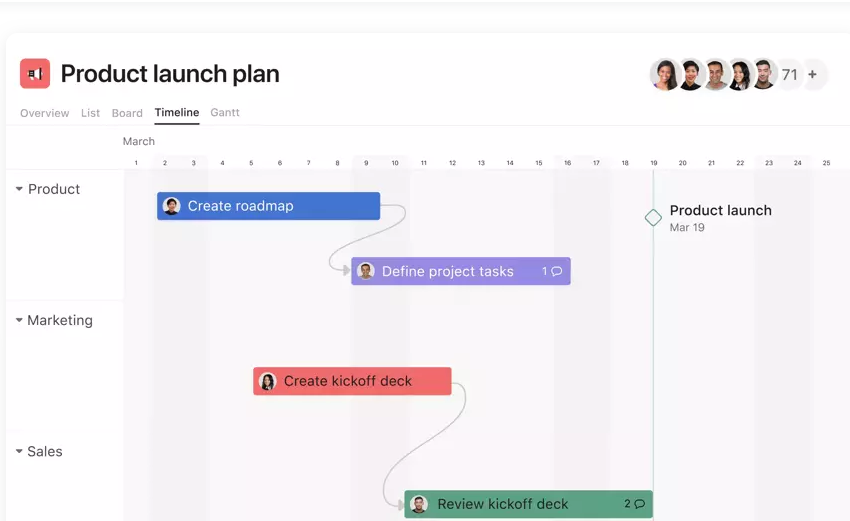
Asana is a popular workflow management tool that helps teams organize and manage tasks, projects, and deadlines. With features such as task assignments, due dates, and project timelines, Asana keeps teams aligned and on track. Integration with other tools like Google Drive, Slack, and Dropbox further enhances collaboration and efficiency.
Key Features:
- Task assignments and due dates
- Project timelines and progress tracking
- Integration with popular work applications
- Customizable dashboards for personalized views
Pros:
- User-friendly interface with intuitive task management
- Flexible enough to accommodate various workflow styles
- Robust collaboration features, including comments and attachments
- Free version available for small teams
Cons:
- Advanced features limited to paid plans
- Steeper learning curve for complex project setups
Learn about Asana’s pricing here.

Trello is a simple yet powerful workflow tool based on the Kanban methodology. It uses boards, lists, and cards to organize tasks and projects visually, making it easy for teams to see progress at a glance. With features like customizable boards, labels, and checklists, Trello adapts to various workflows and project management styles.
Key Features:
- Visual task management with boards and cards
- Customizable workflows with labels, checklists, and due dates
- Integration with popular work applications
- Collaboration features like comments and attachments
Pros:
- Easy to use with a simple, intuitive interface
- Flexible enough to manage projects of any size or complexity
- Free version available with essential features
- Mobile app for access on the go
Cons:
- Limited automation and reporting capabilities compared to other tools
- May not scale well for very large teams or complex projects
Learn about Trello’s pricing here.

Hive is designed as a project and task management workflow tool. It’s specifically well-liked for teams who need to collaborate daily. Users are given the freedom to construct their workflows between commonly used work applications and Hive.
Logic features and triggers can be used to streamline process automations. This workflow tool helps teams perform their documented processes to deliver the same results each time.
The workflow tool also allows for variations in expected results. It allows teams to construct multi-step workflows where they can input different variables to align with these variations.
Hive’s features include:
- Automation capabilities can be applied to recurring tasks
- Easy integratation with other work applications
- Document and video proofing for reduced errors
Pros:
- Tasks can be used in a calendar, kanban, Gantt, and status view
- Users have +1,000 integration capabilities with popualr work apps
- Deleted tasks are still accessible for up to 30 days
Cons:
- Users complain about difficult navigation and usability
- Notifications appear as a pop-up message and you don’t have the option to view them in an inbox
Learn about Hive’s pricing here.
The best workflow tool for documenting guides
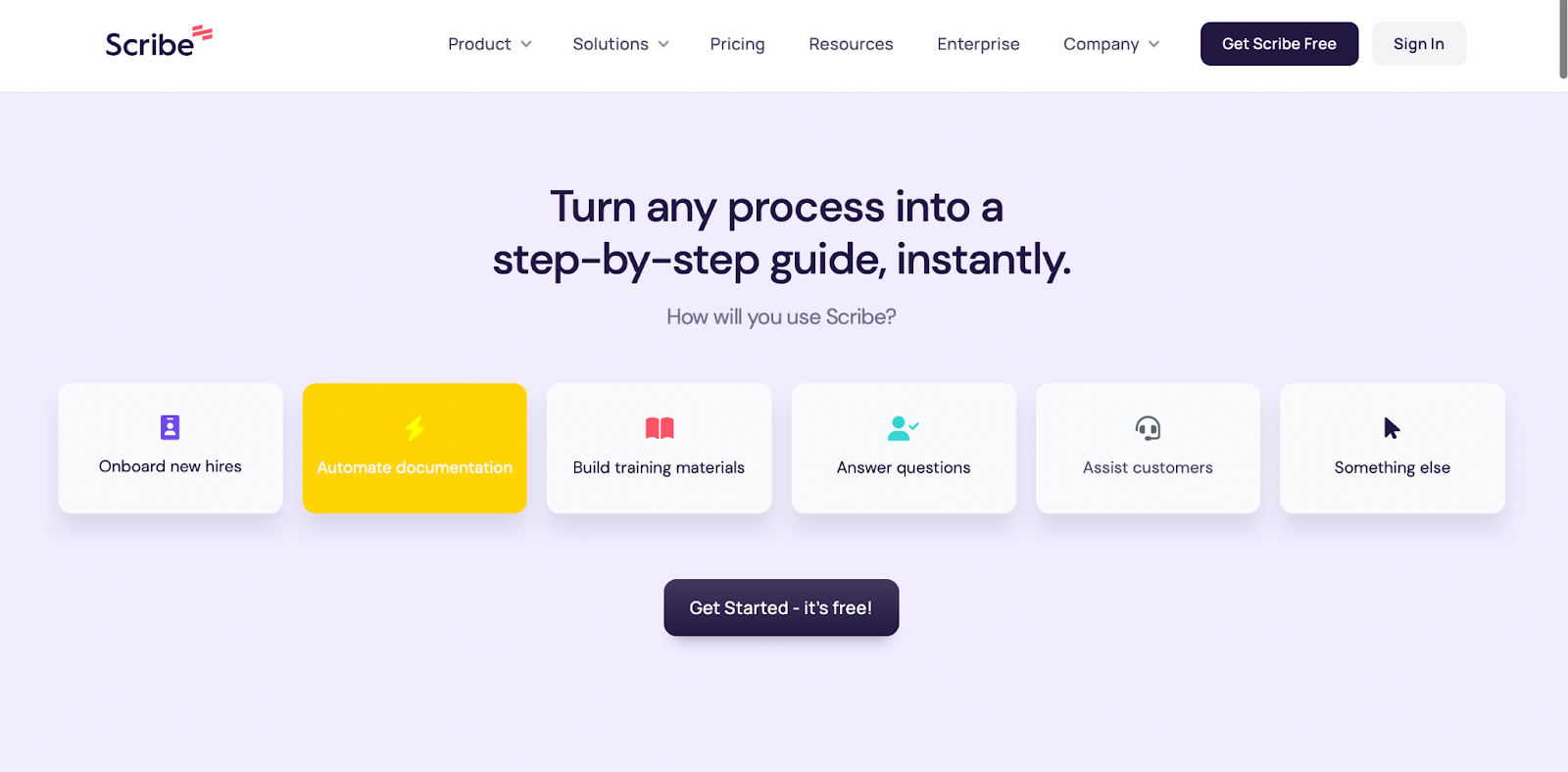
Scribe is a no-code platform that allows you to easily document workflows. This ensures knowledge workers don’t waste time documenting and rather focus their efforts on delivering accurate results.
The workflow tool is designed as a desktop application and Chrome extension, and records your work in real-time. A shareable guide is created from your clicks and keystrokes and provides written instructions with annotated screenshots.
You can then share these guides through a link or embed it into another platform. This includes process management software, content management systems, and knowledge bases.
Scribe’s features include:
- Analytics for you to see when your guides are being used and how often.
- Quick use with Recommended Scribes that are pushed through your Chrome extension when you’re on a familiar website, helping you find the process you need.
- Integratation capabilities with process management, learning management, digital transformation, content management, and knowledge management software.
- Easily shareability with an embed or link (and set permissions to control accessibility).
- No-code functionality to quickly create and edit visual step-by-step tutorials.
Pros:
- You can integrate with many tools
- Easy to use with a small learning curve
- Helps knowledge workers save time and be more productive
Cons:
- Not designed to automate workflows, only streamline the documentation process
- Can’t be used for collaborative work
Learn about Scribe’s pricing here.
What is a workflow tool?
A workflow tool is a software application used to streamline, automate, and manage business processes.
It helps in organizing and optimizing the sequence of tasks within a workflow, ensuring efficient and productive operations.
In business processes, a workflow tool plays a crucial role in streamlining routines by providing a systematic approach to task management.
It automates repetitive tasks, reducing manual effort and minimizing the chances of errors.
It offers an overall picture of the workflow, enabling managers to monitor the progress and identify bottlenecks in the process.
The must-have features of all workflow tools
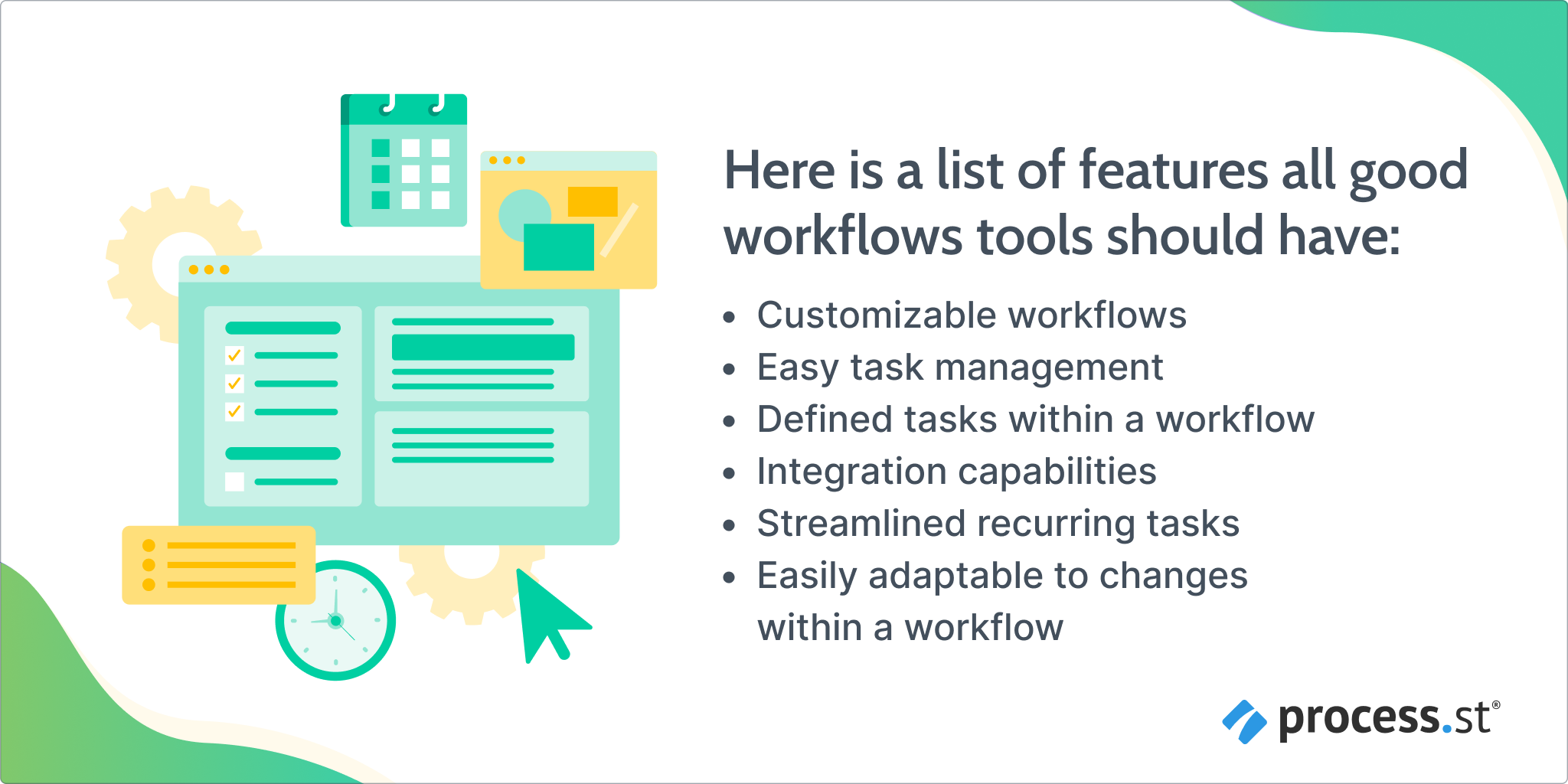
The workflow tool you use should be an advanced platform that empowers you to improve the way you work. It helps you to customize your workflows to meet your team’s specific needs while locating redundancies and bottlenecks.
Here are the must-have features you need from a workflow tool in order for it to be a worthwhile investment:
- Customizable workflows
- Easy task management
- Defined tasks within a workflow
- Integration capabilities
- Streamlined recurring tasks
- Easily adaptable to changes within a workflow
What is the best workflow tool?
When evaluating the best workflow tool, it is important to consider several key features:
Collaboration features
Team collaboration tools are crucial for enabling seamless communication and coordination among team members, such as shared calendars, file sharing, and real-time messaging.
Automation in workflow tools
Automation capabilities can significantly improve productivity and efficiency by automating repetitive tasks, workflows, and approvals.
Tracking performance
Tracking and analyzing performance metrics is also important for making data-driven decisions and continuously improving processes. This includes features such as customizable reports, dashboards, and analytics.
Task follow-ups
Task follow-up features are essential for ensuring that nothing falls through the cracks, such as reminders, notifications, and task prioritization.
Does Microsoft have a workflow tool?
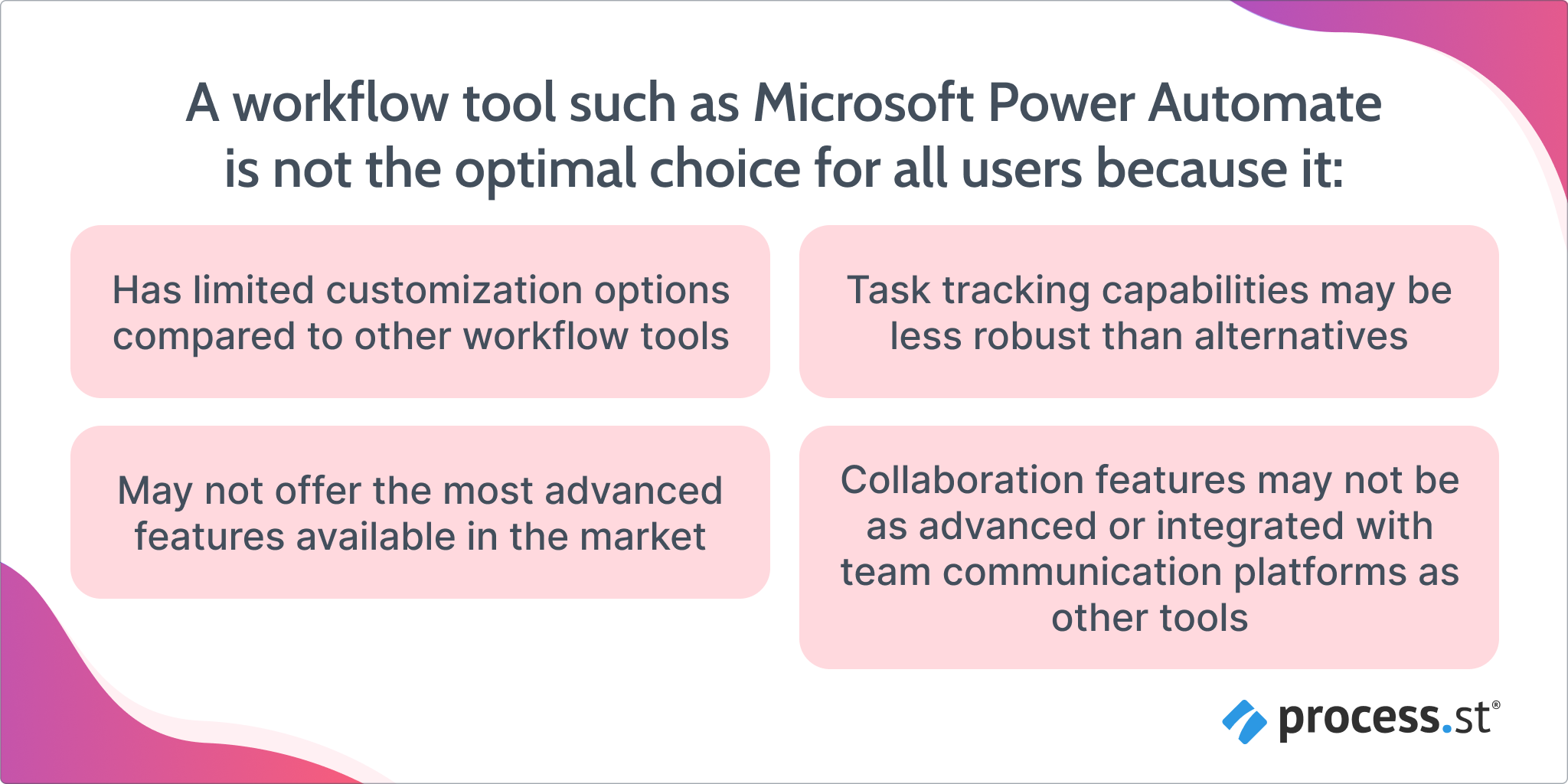
Yes, Microsoft offers a workflow tool called Microsoft Power Automate.
While Microsoft does offer a workflow tool called Microsoft Power Automate, it may not necessarily be the optimal choice.
Power Automate does come with useful features such as automations, task tracking, and collaboration. It allows users to create automated workflows and streamline repetitive tasks across various Microsoft applications and third-party services.
However, some users may find that better options are available. While Power Automate offers a wide range of pre-built connectors and templates for easy integration, other workflow tools may provide more advanced features or better customization options.
In terms of task tracking, Power Automate provides users with a user-friendly interface for monitoring workflow progress and task statuses. However, other tools may offer more robust tracking capabilities or more intuitive interfaces.
Similarly, while Power Automate offers collaboration features that allow multiple users to work together on workflows or tasks, other tools may offer more advanced collaboration functionalities or better integration with team communication platforms.
Does Google have a workflow tool?
Google does offer several tools within its Google Workspace and Google Cloud platforms that can function as workflow tools.
These tools, including Google Docs, Sheets, and Slides, allow for collaborative task management, data collection through form creation, and automated data processing.
However, while Google Workspace provides a range of applications to enhance workflow efficiency, it is not a particularly comprehensive option.
While Google Drive facilitates file storage and sharing, Google Calendar assists with scheduling and time management, and Gmail facilitates communication, these tools may lack certain advanced features found in dedicated workflow platforms.
Google Cloud’s offerings, such as Cloud Functions, Cloud Composer, and Cloud Workflows, do provide workflow automation capabilities. Yet, users seeking more advanced automation features or deeper integration options with various applications and services may opt for alternative solutions.
Workflow tools: Pick wise or see your company’s demise
Business processes are a vital part of your company’s operations and need to be manage efficiently. Workflow tools help you document these processes and then optimize them.
Without these tools, you’re likely running your processes slower, and with a higher risk of error.
The market for workflow tools is incredibly competitive, but very few options provide the comprehensive features you need to be effectively managing your company workflows.
That’s why you should make sure to search for features that these five best workflow tools offer. This way, you’re assured a reliable workflow management tool.







